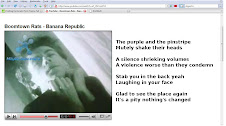
 Manager Lee Bazzle stands by the furnace where our trash is burned Stratton Lawrence
Manager Lee Bazzle stands by the furnace where our trash is burned Stratton Lawrence Near Spruill Avenue in North Charleston, along the bank of Shipyard Creek, sits a massive, fiery cauldron. After a garbage truck empties the trash can in front of your house, four out of five times it then heads toward Charleston County's incinerator, the only municipal trash-burning facility still operating in South Carolina. Once there, plastic bottles, batteries, candy wrappers, dirty diapers, and banana peels are shoved together into the scorching inferno, reducing their total mass by over two-thirds. The ash that's left (47,000 tons last year) is dumped in the landfill. Much of the mercury, particulate matter, and poisonous dioxins created are captured by activated charcoal and static electricity in an "electrostatic precipitator." But take a not-too-deep breath ... what's not caught blows into the air over Charleston.
"We've been burning trash since the days of the cave man," says Bob Guild, a Columbia, S.C., lawyer who's worked on several incinerator cases. "You can dress people up in white outfits and have sophisticated machines, but the bottom line is we're using a technology about as primitive as human culture itself to manage our waste."
Two months ago, the incinerator was all but toast. Due to costs and environmental concerns, Charleston County Council voted to discontinue its use when operator Veolia-Montenay's current contract expired, instead diverting future trash to the Bees Ferry and pending Adams Run landfills. With 80 percent of our garbage currently being burned (230,000 tons each year), that would have meant the rapid growth of our own Mt. Trashmore in West Ashley. Bees Ferry-area homeowners then became upset about a pile of trash potentially as high as the round Holiday Inn. Veolia-Montenay came back with a plan to install a $10 million "bag house" vacuum that would cut mercury emissions by 70 percent and particulate matter in half, and Charleston County's Solid Waste department showed interest.
Councilwoman Colleen Condon now says it's "extremely likely" that they'll go forward with the incinerator, extending Veolia-Montenay's contract for 20 more years, with a possible provision allowing for 10 more in addition to that.
"The agreement we have on principle is very satisfactory to most council members. We just have to fine-tune the details about emissions levels," she says.
Our incinerator currently emits 129 pounds of mercury into the air each year from batteries, light bulbs, and other items that people put in the trash. Only four power plants in the state emit more. Even minute amounts of mercury in our body can effect neurological development, and it's a suspected factor in the autism epidemic. The 2,600 degree temperatures in the furnace also create a prime habitat for the creation of dioxins, among the most toxic chemicals to the human body and environment.
Gregg Varner, the county's director of solid waste, stresses that no renewal agreement has yet been signed and that the current contract doesn't end until 2010, but council's Special Finance Committee will discuss the issue at their May 20 meeting. He says the improvements include a turbine upgrade, which will allow the creation of more electricity from the incineration process. Currently, the "waste-to-energy" plant generates enough to power 7,000 to 10,000 homes, which is used to run the incinerator and provide revenue by selling the excess to North Carolina utility CP&L. Varner also touts a ferrous metal recovery system which will pull metal scraps from the ash pile and allow them to be recycled.
Coinciding with the decision to extend the incinerator's life at least 20 years, County Council has proposed a "Green Ribbon Committee" to explore ways of making the county's operations more environmentally responsible. Councilwoman Condon says that at a recent solid waste public meeting, constituents expressed a desire for a comprehensive strategy to promote recycling and reduce waste.
But the technicalities of the incinerator's contract could actually discourage the active pursuit of that goal. The contract has a minimum tonnage agreement that assures Veolia-Montenay 175,000 tons of garbage each year. The county's cost to incinerate decreases after meeting that goal, creating an economic incentive to burn as much as possible.
Kevin Richardson, a local soil and waste expert and a member of the subcommittee on waste and recycling for the city of Charleston's Green Council, worries that such agreements will preclude future efforts to pick up recycling from businesses, a service currently not offered by the county. Ideas like weighing household trash with a scale on the truck, and charging users accordingly, might also be discouraged.
"I just don't see how burning trash is a good way to manage the situation, especially when there's so many viable alternatives that are good for the environment, people, and business," says Richardson. "I think that within the next 20 years, it'll be common knowledge that burning trash is terrible, so why would we legally bind ourselves to it for 20 years now, when we know it's a bad thing to do?"
Attorney Guild points out that federal cap-and-trade carbon emission laws could also end up costing the county money if imposed during the duration of a binding contract.
"It's a devil's bargain what we do with our waste, because we're inevitably transferring it from one medium to another, whether it's a hole in the ground or into the air," says Guild. "But by the process of incineration, you liberate large volumes of mobile materials into the atmosphere that are hazardous to human health. It's a way of spreading our pollution very broadly to our lungs and environment."
The value of recyclables continues to rise, as does the cost of waste disposal. With the current contract good until 2010, environmentalists like Guild and Richardson hope that council will carefully consider profitable alternatives before fast-tracking the county into 20 more years of burn, baby, burn.





















